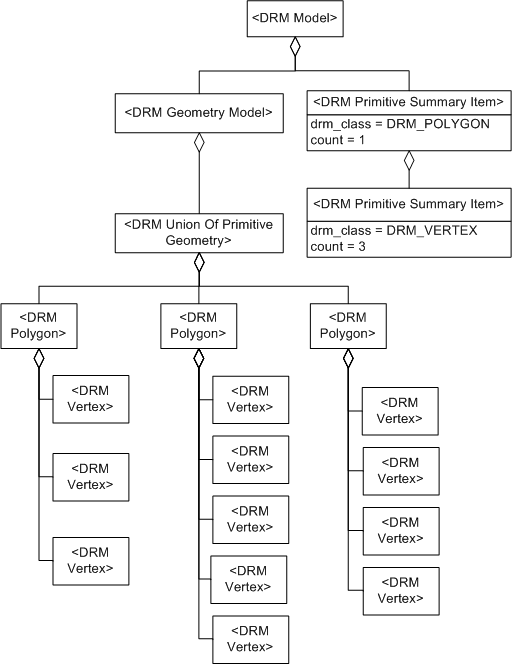Class Name: Primitive Summary Item
Subclasses
This DRM class is concrete and has no subclasses.
Definition
An instance of this DRM class specifies a common pattern of
primitive objects that appear in the scope being summarized,
which may be either a <Model> instance or
an <Environment Root> instance. A
<Primitive Summary Item> instance represents one or more
instances of the class specified by its
drm_class field
that conform to the specified pattern.
A <Primitive Summary Item> instance may represent only
instances of <Primitive Geometry>, the
<Primitive Feature>,
and the classes that may appear in their component
trees. <Primitive Summary Item> instances are combined
to form a hierarchy mirroring that of the primitive instances that
they represent such that the summary is a compressed form of the
actual hierarchy.
Since a <Primitive Summary Item> instance may represent
many instances of the primitive that it summarizes, it has a
multiplicity field, indicating how many
instances of the pattern it represents.
Note that all instances represented by a
<Primitive Summary Item> instance shall conform exactly to
that pattern, up to the point where the summary's pattern ceases to
provide specifics.
Primary Page in DRM Diagram:
Secondary Pages in DRM Diagram:
Example
Summary of a common <Polygon> instance structure pattern
within a <Model> instance.
In this case, the pattern indicates that a data consumer can expect
to see triangles. Other patterns can be present. As depicted in
Figure 6.40, the <Model> instance
contains not only triangles, but other types of
<Polygon> instances, such as quadrilaterals and
even five-sided <Polygon> instances. The
<Primitive Summary Item> instances
indicate common patterns and are not enumerating
all the patterns that are present.

Figure 40 — <DRM Primitive Summary Item> example
FAQs
-
Consider an <Environment Root> instance E
with a <Primitive Summary Item> component, specifying a
pattern of usage for instances of a given class.
Does this mean that all instances of that class in
the scope of E shall comply with the specified pattern?
No; it only indicates that the specified pattern is very common
within the scope of E.
Consider an <Environment Root> instance E
with a <Primitive Summary Item> component describing a
texture-mapped triangular <Polygon> instance - that is, a
<Polygon> instance with
an <Image Mapping Function> component and
three <Vertex> components. All that this means is that
<Polygon> instances of that description are common
in the scope of E.
-
Can the usage of a given class be simultaneously and unambiguously
summarized by a
<DRM Class Summary Item> instance and a
<Primitive Summary Item> instance in the same scope?
Yes, because the <DRM Class Summary Item> class and
the <Primitive Summary Item> class
summarize different aspects of usage.
The <DRM Class Summary Item> class
summarizes the presence of instances of the specified class,
while the <Primitive Summary Item> class
represents common patterns of DRM objects in which
instances of the specified class appear.
Constraints
Composed of (two-way)
Composed of (two-way metadata) (inherited)
Component of (two-way)
Notes
Composed of Notes
If present, the list of
<EDCS Use Summary Item> components
of a <Base Summary Item> instance
summarize EDCS usage by instances
of the class specified by
drm_class that occur
somewhere in the scope being summarized.
Fields Notes
The drm_class
field indicates the DRM class of the DRM object(s)
represented by the
<Base Summary Item> instance.
The multiplicity field indicates
the number of identical instances represented.
Prev: Primitive Geometry.
Next: Process Step.
Up:Index.
